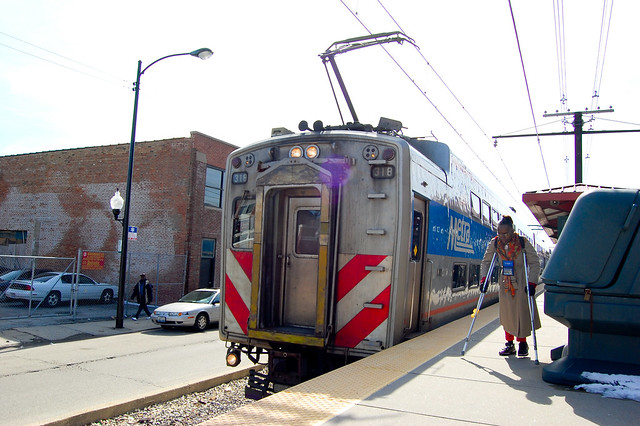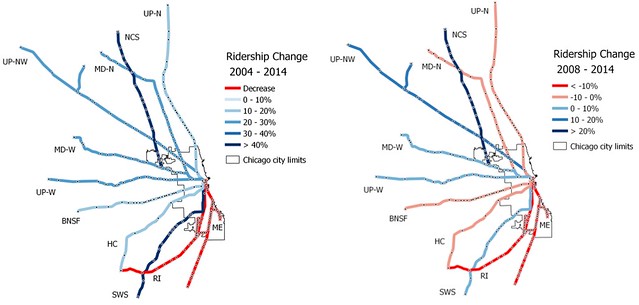
Toronto's suburban commuter rail service, GO Transit, used to run its trains on a schedule that would seem familiar to Metra riders -- bringing commuters from the suburbs in by 9 a.m. and shuttling them from the city after 5 p.m. Last year, though, it launched a new schedule that doubled mid-day frequencies on its two Lakeshore rail lines, from once per hour to every 30 minutes, "turning GO from a bedroom commuter service into full, regular transit," said Ontario transportation minister Glen Murray. Their reward: a 30 percent increase in ridership on those lines in a year's time.
Yonah Freemark, writing in The Transport Politic, identifies three characteristics that led to GO Transit's strategy shift: high-level political leadership at the provincial (state) level, committed leadership and a new strategic direction within the agency, and the fact that GO owns most of its tracks.
Over here on the other side of the Great Lakes, commuter rail ridership on Metra has been growing much more slowly. Some lines are growing, but other lines are declining. Metra, like GO, could gain riders if it switched to "all-day" service that served people whenever they need to use transit -- serving people on their schedules, instead of making people adapt to the train's schedule.
Metra focuses on a central core system, mostly serving workers commuting to downtown Chicago from the suburbs in the morning and back in the evening. Even on the Metra Electric line, which before World War Two ran a rapid-transit like ten trains an hour past high-rises in Hyde Park and South Shore, just one train stops at most stations during the noon hour. It's hard to use Metra for spontaneous trips – and trips for all of life's purposes, not just work or carefully planned day trips – if you might have to wait an hour or two for a train.

If Metra wants to expand all-day service, it should start where GO started -- with leadership. Two consecutive Ontario provincial premiers (governors) campaigned on adjusting the budget to prioritize transit, and raising taxes to provide more transit service. Whether that means new subways, new streetcars, or both has been a long battle ever since, but improving service on the Lakeshore lines was one quick way to start -- the tracks, trains, and stations were already there. Three more GO lines will soon follow, and long-term plans include gradual capital improvements to support even more frequent service.
In Chicago, the push for more transit resources recently got a jump-start when the Active Transportation Alliance and Center for Neighborhood Technology launched the Transit Future campaign, pushing Cook County commissioners to come up with new local transit funding. Those funds could expand transit infrastructure and service faster than usual, adapting Los Angeles's strategy using local tax revenues to match billions of dollars in federal grants and loans. Many Cook commissioners have signed on to the campaign, but so far only to say they agree that it should happen.
A few extra track connections could also make it easier to run trains across the region. The Midwest High Speed Rail Association has advanced CrossRail Chicago, which would expand suburb-to-suburb options and make it possible to run frequent trains from the northwest suburbs to the south side.
Priorities and leadership within Metra are also shifting. Metra recently started developing a new strategic plan in July 2012, with the most recent progress being a board presentation in January. Spokesperson Tom Miller said then, "due to leadership changes, and the need to focus on a few other pressing priorities, it was delayed in its completion." A source who worked closely with Metra and asked to remain anonymous said the process was delayed because of the CEO scandal, board shakeup, and most recently because of the need to finalize the next budget.
The strategic plan that GO Transit adopted in 2007, according to Freemark, indicated the agency’s move "beyond just serving peak travelers into central Toronto." Metra's plan, according to the source, is not about operations or service, but "directs overall strategic planning" and discusses Metra's role as a transit provider now and in the future, its strengths and weaknesses, and "how could it serve its customers better." These answers will then inform a set of policies which could lead to service changes, the source said.
That's with an emphasis on the "could." The January presentation [PDF] recommended "reverse commute" and "express/limited stop service" as policies to develop -- but then ranked service enhancement and expansion last in their capital priorities. Some of the other strategic planning policies in the plan include how Metra interacts with other transportation modes, how it manages parking, and transit-oriented development around stations.
The strategic plan could also consider how much track Metra owns, which is a huge advantage when trying to run more trains down the track. While Metra doesn't own 70 percent of its track like GO does, Metra does own several lines outright, and leases the tracks out to freight railroads. Metra owns 36 percent of the routes it runs on, notably the entirety of the Rock Island District, the Electric line and its branches, and the Milwaukee West line to Elgin. The Rock Island and Electric lines – both with closely spaced stops within the city – are showing the greatest ridership declines, even though they run through many transit supportive neighborhoods on the south side.
Metra spokesperson Miller said we can expect to hear more about the strategic plan at Metra's next board meeting, on August 15.





